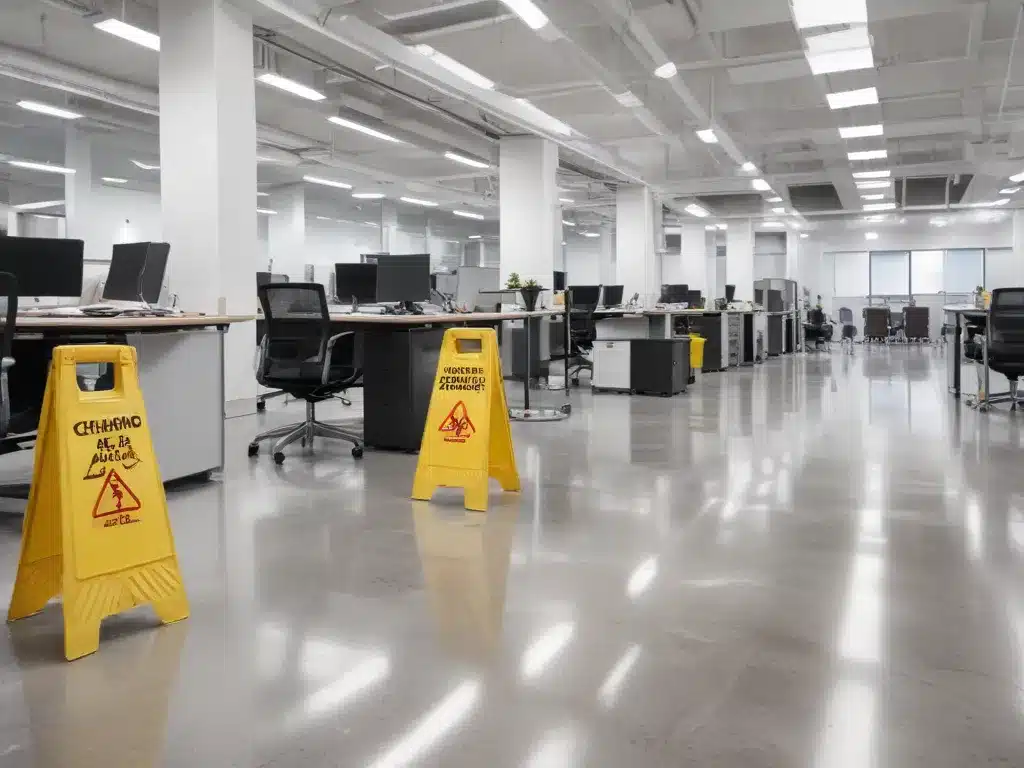Introduction
As a business owner or facility manager, maintaining a clean and hygienic office environment is crucial for employee productivity, client satisfaction, and overall professionalism. However, traditional cleaning methods can be time-consuming, labor-intensive, and sometimes ineffective. Fortunately, the cleaning industry has been embracing new innovations that promise to revolutionize the way we approach office cleaning. In this article, I will explore some of the latest advancements in cleaning technology and techniques that are improving efficiency, reducing environmental impact, and ensuring a healthier workplace.
Robotic Cleaning Solutions
Robotic cleaning solutions have been gaining traction in the commercial cleaning industry due to their efficiency and consistency. These autonomous machines can perform various cleaning tasks such as vacuuming, mopping, and even disinfecting surfaces. One prominent example is the Autonomous Mobile Robot (AMR) technology developed by companies like Avidbots. Their Neo floor-scrubbing robot utilizes advanced sensors and mapping capabilities to navigate through office spaces, optimizing cleaning routes and ensuring thorough coverage.
The benefits of robotic cleaning solutions extend beyond labor savings. They can operate around the clock, minimizing disruptions to office operations, and ensure consistent cleaning quality. Additionally, these robots can collect data on cleaning patterns, allowing facility managers to identify areas that require more attention or adjust cleaning schedules accordingly.
Electrostatic Disinfection Technologies
In the wake of the COVID-19 pandemic, there has been an increased focus on effective disinfection methods in office spaces. Electrostatic disinfection technologies have emerged as a game-changer in this area. These systems use electrostatic sprayers to disperse disinfectant solutions with an electrical charge, allowing the droplets to adhere to surfaces more effectively, ensuring complete coverage, even in hard-to-reach areas.
Companies like Victory Innovations and EvaClean offer electrostatic disinfection solutions that can quickly and efficiently disinfect large office spaces. These systems not only enhance the effectiveness of disinfection but also reduce the amount of disinfectant required, making them more environmentally friendly and cost-effective.
Sustainable Cleaning Products and Practices
As environmental concerns continue to rise, the cleaning industry has responded by developing sustainable cleaning products and practices. Many companies are now offering eco-friendly cleaning solutions that are biodegradable, non-toxic, and free from harsh chemicals. These products are safer for both the environment and the individuals using them, reducing the risk of exposure to harmful substances.
In addition to sustainable cleaning products, there has been a shift towards more environmentally conscious cleaning practices. For instance, techniques like microfiber cleaning and the use of high-efficiency particulate air (HEPA) vacuums can significantly reduce water and energy consumption while improving indoor air quality.
IoT and Smart Cleaning Solutions
The integration of the Internet of Things (IoT) and smart technologies has opened up new possibilities for optimizing office cleaning processes. Smart cleaning solutions leverage sensors, data analytics, and connectivity to monitor and manage various aspects of cleaning operations.
For example, companies like Tork and Kimberly-Clark offer smart restroom systems that utilize sensors to track restroom usage, paper product levels, and cleaning schedules. This data can be used to optimize cleaning schedules, reduce waste, and ensure that restrooms are always well-stocked and properly maintained.
Additionally, IoT-enabled cleaning equipment, such as smart vacuum cleaners and floor scrubbers, can provide real-time data on performance, maintenance needs, and usage patterns, allowing for more efficient resource allocation and predictive maintenance.
Training and Certification Programs
While technological advancements are revolutionizing the cleaning industry, the human element remains crucial. To ensure that cleaning professionals are equipped with the knowledge and skills necessary to leverage these new innovations, various training and certification programs have emerged.
Organizations like the International Sanitary Supply Association (ISSA) and the Building Service Contractors Association International (BSCAI) offer comprehensive training programs that cover topics such as advanced cleaning techniques, sustainable practices, and the use of specialized equipment. These programs not only enhance the competencies of cleaning professionals but also promote industry standards and best practices.
Real-World Examples and Case Studies
To better illustrate the impact of these innovations, let’s explore some real-world examples and case studies:
-
Robotic Cleaning at the University of Texas at Austin: The university implemented Avidbots’ Neo floor-scrubbing robots in their facilities, resulting in a 40% increase in cleaning productivity and significant labor cost savings. The robots also provided detailed data on cleaning patterns, allowing the facility managers to optimize their operations.
-
Electrostatic Disinfection in Healthcare Facilities: Several hospitals and healthcare facilities have adopted electrostatic disinfection technologies to enhance their infection control measures. For instance, the University of Pittsburgh Medical Center (UPMC) reported a significant reduction in healthcare-associated infections (HAIs) after implementing electrostatic disinfection protocols.
-
Sustainable Cleaning at Google Offices: Google has been a pioneer in sustainable cleaning practices, incorporating eco-friendly cleaning products and techniques across their offices worldwide. They have implemented microfiber cleaning systems, HEPA vacuums, and green cleaning chemicals, resulting in reduced water and energy consumption while maintaining a healthy indoor environment for their employees.
-
Smart Restroom Solutions in Commercial Buildings: Several commercial building managers have implemented smart restroom systems from companies like Tork and Kimberly-Clark. These systems have helped optimize restroom maintenance schedules, reduce waste, and improve overall customer satisfaction by ensuring that restrooms are always clean and well-stocked.
Conclusion
The cleaning industry is undergoing a transformative phase, driven by innovative technologies, sustainable practices, and a heightened focus on health and safety. From robotic cleaning solutions to electrostatic disinfection, sustainable cleaning products, and IoT-enabled smart systems, these advancements are revolutionizing the way we approach office cleaning.
As a business owner or facility manager, embracing these innovations can lead to increased efficiency, cost savings, and a healthier work environment for your employees and clients. However, it is crucial to stay informed about the latest developments, provide adequate training for your cleaning staff, and partner with reputable cleaning service providers who are at the forefront of these advancements.
By adopting the latest innovations in office cleaning, you can not only enhance the cleanliness and hygiene of your workspace but also contribute to a more sustainable and environmentally responsible future.







